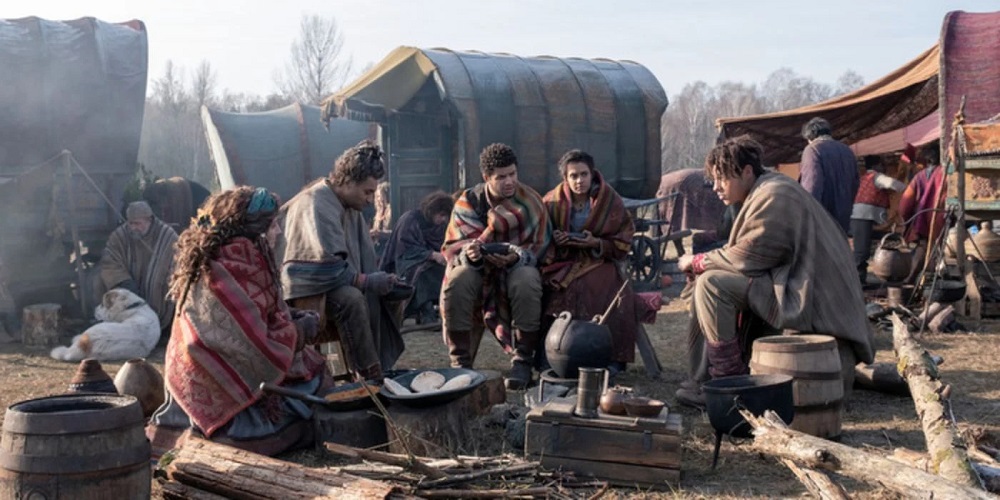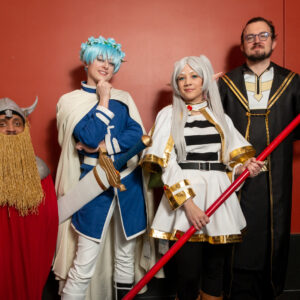A Costumer’s Look At The Wheel of Time: Eps. 3&4, The Tinkers

For this article, I am combining Episodes 3 and 4 of the Amazon Prime series The Wheel of Time so I have enough time to talk about the Tuatha’an Mahdi, also known as the Tinkers. They are a group of people living communally in wagons wandering from place to place searching for “the song.” Think of them kind of as Robert Jordan’s version of the Romani.
The first time we meet the Tinkers we are with Perrin and Egwene, and we see them as silhouettes in the fog but it is not your standard silhouette. It is a little off for humans, kind of boxy, but when they come into focus you can clearly see things, that to a costumer, give them away as nomads. The oversized garments, the layering of clothing to keep warm, even down to the fabric strips sewn to the hems on most of the garments, tell of a lack of space and a very changeable environment.
The Tinkers and the people of Two Rivers, probably, have similar problems when it comes to clothes, but they go about solving them in ways that are unique to their station as stationary villagers, in the case of the residents of Two Rivers, and as a nomadic people, in the case of the Tinkers. We discussed the idea of hand-me-downs in the first article of this series, but I feel that the Tinkers might, out of necessity, have to take this idea to the extreme.
In Episode one’s article, I talked about the necessity of the Two Rivers folk to re-dye garments when they get faded from washing. Odds are, the Tinkers don’t have that capability. Access to things like dyes is very regional, since the dyes are made from natural materials. They would also need a large amount of water to work through the dying process. While Emond’s Field and surrounding Two Rivers residents might cultivate plants for dying because of the wool they produce for sale, Tinkers are nomadic, so they would need to find these plants growing naturally and in enough quantities to dye something. Adding to the difficulties, some dyes need to be harvested at a certain time of year — if you don’t get to that plant at the right time, then it’s useless. Also, some can be deadly to eat so the pots that you use can now only be used for dying, which is a waste of valuable space. Similarly, in the case of some berries, either you dye with them, or you can eat them. The Two Rivers is ideally placed to re-dye fabrics that fade, whereas the Tinkers are not, which gives them a much more gray, tan, or terracotta dust base for their garments. It probably also helps camouflage them, allowing them to move unmolested through the landscape more easily. This is important to the Tinkers, as we find out they follow the way of the leaf, essentially acting as pacifists and that they are not seen favorably by townspeople who might kill them.
Their overall bulky silhouettes, especially on the men, might act in two ways. One would be intimidation, like with Lan — because an attacker can’t see their actual size this might cause them to hesitate. But probably more important to the Tinkers is the second reason for their boxy shape — they can fit more layers underneath to keep warm. Unlike our Emonds Fielders who have the luxury of a settled lifestyle which allows, yhup… coats.
Coats are really a one purpose garment, generally you wear them when you know it will be cold, which really only happens a quarter of the year. They live by my motto when people ask why I hate summer: “You can always put on more layers, but you can only take so many off before it is a crime.” For someone who is traveling as the Tinkers do, the temperature they experience may vary greatly from morning to evening, and even throughout the day, depending on where they are at a given time. Additionally, when space is at a premium, like in a wagon, a one purpose garment just takes up space. If a person has three pieces of clothing, when they are not wearing them three other people can wear them. If you replace the three garments with one coat, when that coat is not in use by the owner only one other person can wear it. Or, it might just be too warm for anyone to wear that coat, and now it is just taking up space in the wagon, taking up space where a multi-use or more flexible item, like a blanket, shawl, wrap or poncho could fit. These things are multi-use, like a blanket or shawl as well as multi-size, like a poncho or wrap and all of these things can still be used to keep you warm.
Another thing the Tinkers and Emond’s Fielders need to figure out is making a garment longer or shorter depending on the person it is being given to.
Like the folks of Two Rivers, the Tinkers are a small group, but in comparison to the population of a Tinker band, the villages of Two Rivers look like cities. So, the clothing pool is much, much smaller for the Tinkers. We still see similar loose-fitting tops, skirts and pants (so we can layer), but the Tinkers alter their clothes differently length-wise. In Two Rivers, having a garment with a 7-inch hem will probably not really affect much, but when someone is going to be walking all day, the weight of the extra fabric especially around the legs is going to become a problem. Tinkers correct this issue by adding strips of fabric. This also helps by reducing the total amount of primary fabric in an overall garment, and more fabric makes the garment more expensive as well. When a garment starts to get too small around the body, they can take off the “hem strips”, give the original garment to a smaller child and put the hem strips onto a garment for someone that has grown over the months. It is easier to remove a row of strips than to make entirely new pants or take down a hem and then raise it again (I will just take off these three strips instead of all seven). The extra fabric could also be moved to the sleeves to make them longer, or down the leg to make them overall wider. Strips are overall cheaper, could be scraps or ribbons and, if necessary, easier to steal. You have less of a chance of being noticed, and people might not care as much if you’re not stealing a whole bolt of fabric.
We don’t really think too much about the difference that settling in one place has on our overall appearance and garment choices. Of course, nomadic dress will also be influenced by cultures the Tinkers come into contact with. Is this garment useful or not? When clothing multiple people, the more uses you can get out of a garment, whether it is layering or being able to sleep in it as a blanket, making them longer or shorter, bigger or smaller you will find a way. And you better believe that color doesn’t matter to the wearer. Mixing colors and prints seems like a small thing compared to dying of exposure.



